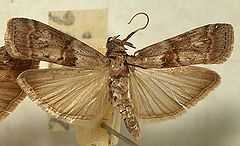Phycita
| Phycita | |
|---|---|
 | |
| Phycita roborella specimen | |
| Scientific classification | |
| Kingdom: | Animalia |
| Phylum: | Arthropoda |
| Class: | Insecta |
| Order: | Lepidoptera |
| Family: | Pyralidae |
| Subfamily: | Phycitinae |
| Tribe: | Phycitini |
| Genus: | Phycita J.Curtis, 1828[1] |
| Type species | |
| Tinea spissicella Fabricius, [1777] | |
| Synonyms | |
|
[2] | |
Phycita is a genus of small moths belonging to the snout moth family (Pyralidae). They are the type genus of their tribe Phycitini and of the huge snout moth subfamily Phycitinae.
The type species of this widespread genus is Phycita roborella, under its obsolete name Tinea spissicella. This is believed by many authors to have been described in J. Fabricius' Entomologia systematica in the 1790s. However, it appears that Fabricius described the species in his 1776/1777 Genera insectorum already. Fabricius himself established the present genus under the name Phycis.
But this name had already been used for a genus of northern hakes by P. Artedi in his catalogue of fishes (Petri Artedi sueci genera piscium), edited and published posthumously by J. Walbaum in 1792. When this name was replaced, Fabricius' earlier description of the type species was overlooked, eventurally rendering it a nomen oblitum. In any case, the same moth had been first described as Phalaena (Tinea) roborella by M. Denis and I. Schiffermüller in 1775, and thus their species name has priority over that of Fabricius. Replacement names for Fabricius' Phycis were proposed at almost the same time in 1828 by J. Curtis and L. Thienemann, but the latter's proposal Ceratium was also unavailable, having been established for a dinoflagellate genus by F. v. Schrank in 1793. To add further confusion, some authors have claimed that Ceratium was again established for the present genus in 1848 by J. v. Gistel, but this is not correct – Gistel merely discussed Thienemann's and v. Schrank's names and (unnecessarily) proposed Gyra to replace the latter, adding yet another invalid name to the synonymy of Phycita.
Phycita species can be hard to tell apart from related moths in the field. The combination of 11 veins in the forewing (vein 7 missing altogether) and an upward-pointing "snout" formed by the long and straight labial palps, whose second segment is much longer than the third, may be diagnostic. The caterpillar's food plants are not comprehensively documented, but seem to include trees of the eurosids I clade and perhaps others.[3]
Selected species
Species of Phycita include:[3]
|
|
Footnotes
- ↑ "World Pyraloidea Database". Globiz.pyraloidea.org. Retrieved 2012-02-28.
- ↑ Pitkin & Jenkins (2004), and see references in Savela (2011)
- ↑ 3.0 3.1 Clarke (1986), and see references in Savela (2011)
References
| Wikimedia Commons has media related to Phycita. |
- Clarke, John Frederick Gates (1986): Pyralidae and Microlepidoptera of the Marquesas Archipelago. Smithsonian Contributions to Zoology 416: 1-485. PDF fulltext (214 MB!)
- Pitkin, Brian & Jenkins, Paul (2004): Butterflies and Moths of the World, Generic Names and their Type-species – Phycita. Version of 2004-NOV-05. Retrieved 2011-MAY-27.
- Savela, Markku (2011): Markku Savela's Lepidoptera and some other life forms – Phycita. Version of 2011-MAR-06. Retrieved 2011-MAY-27.